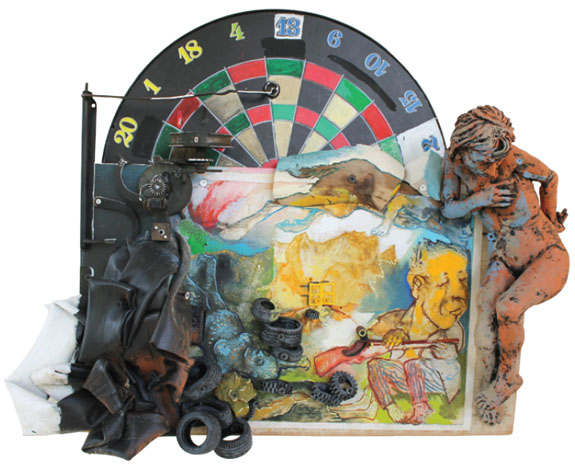 |
.jpg) |
Four of the 21works on view here are freestanding, and only two of these invite the viewer to fully engage them in the round. The remaining 17 hang on the wall, but in most cases seem to want to come off of it, or failing that, to at least jump past the confines of the pictorial rectangle. Only on a few occasions do we see any dimension greater than 30 inches, meaning that, for all of their moments of slap-happy chaos and material rambunction, Olivant’s pieces are best understood as meditations on the state of visual intimacy, albeit one subjected toabsurd disruptions. As an example, take the piece titled Target Practice. Its material basis is a full sized dart board attached to a piece of salvaged plywood, upon which are painted a crouching male figure holding a rifle and two other floating female figures, each a reclining nude. At the right is an additional female figure made of glazed (or painted) ceramic, seeming to be tending a wound while also intruding into the space occupied by the smirking gunman. To the left one sees a small cascade of tiny rubber tires mounted on a measuring device. At the most obvious level of denotation, we see that the tableaux draws equivalencies between eroticism and violence, but the connotations are richer than that, insofar as the male figure seems to convey ambivalence rather than malice.
.jpg) |
If you were to read what I have written in the above paragraphs without seeing the exhibition, you could be forgiven if you assumed that Olivant works squarely within the familiar and pervasive modality of Bay Area art making that was dubbed Funk by Peter Selz in 1967. There is some truth to that assumption, but not nearly as much as many might expect. More interesting are the ways that Olivant’s work extends and deviates from the Funk tradition, adding new elements and incorporating and recalibrating familiar influences. The results are works that are more seductive and poetic than the typical Funk fare, partly so because of their unabashed and unambivalent embrace of the Surrealist tradition of the object trove poetique, and partly because of their wildly elaborated, Rube Goldbergian zaniness that harks back to the older work of Joseph Cornell. Okay, zany may not be the right word, because it signifies the wrong kind of comedy insofar as Olivant’s work is concerned. The right kind of comedy is in fact tragi-comedy, and its achievement lies within a canny balancing of charm, pathos and absurdity that uses figurative fragments to slyly suggest how each of these aspects is a function of the others. This balance is as much a function of form as it is of what is normally called either content or signification, because the most important formal issue that Olivant’s work addresses is the one that stage manages relations between multiple modes of particularity seeking salvation from a runaway complexity that is nothing if not indifferent to human folly.
–MARK VAN PROYEN